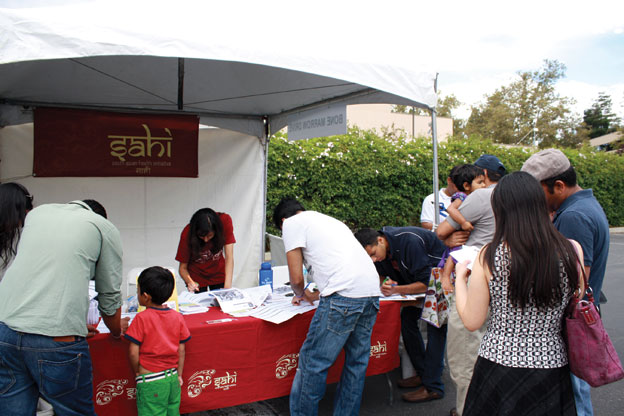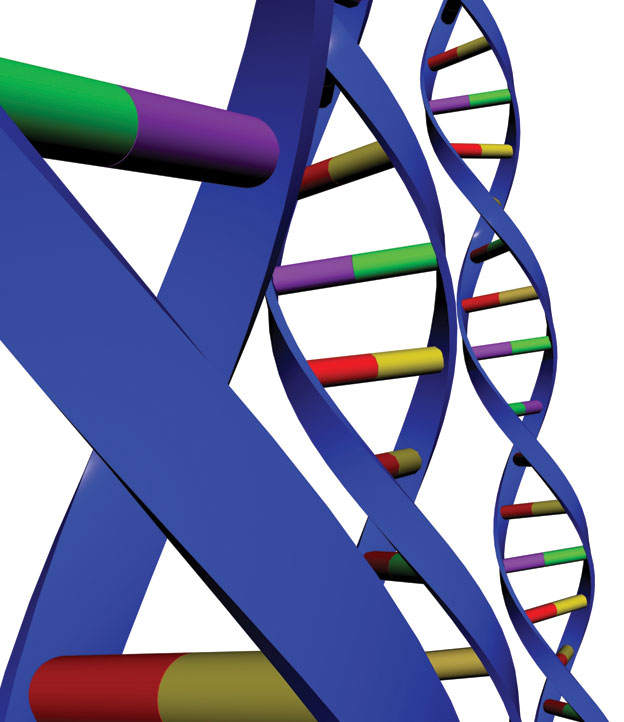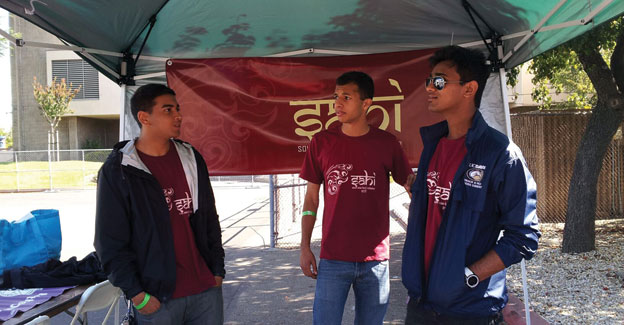YOUTH:
Fighting Cancer: SAHI's Drive to Save Lives
South Asians, and other minority groups lack awareness for the Bone Marrow Registry, and are reluctant to register. SAHI, South Asian Health Initiative, was founded by three college students, aiming to create that awareness and encourage people to register, potentially saving someone’s life, writes Yasaswi Vengalasetti.

(Above): Dhruv Manchala, founder and Manali Sapre, volunteer, busy at work registering new potential donors. [Photo: Shreyas Bharadwaj]
Every four minutes, someone in the United States is diagnosed with a blood cancer, and once every ten minutes, a person in the U.S. dies from a blood cancer. According to the Leukemia and Lymphoma Society, leukemia, lymphoma, and melanoma, the three most common types of blood cancer, are estimated to take the lives of more than 54,000 people in the U.S. in 2013.
Despite the fact that a bone marrow or stem cell donation is frequently a last resort treatment for these patients and not many donations are required, many patients are still having difficulty securing a match. Similar to a blood donation and unlike an organ donation, the physical cost of a bone marrow or stem cell donation is close to nothing for a donor. But due to common misconceptions about its safety and expense as well as a lack of awareness about the registration process, it has been extremely difficult for patients to find donors. The problem becomes even more challenging when a patient belongs to a diverse minority group as there is a much smaller pool of registered donors to find a match.
A bone marrow stem cell transplant replaces a patient’s debilitated marrow cells, which are unable to produce blood cells as they normally would, with healthy ones. However, unlike blood transfusions, marrow transplants are even more exclusive than the 8 blood groups. Patients can only receive transplants from donors who share a similar genetic makeup, typically brothers or sisters. However the probability of finding a match within the family is only about 30%, forcing the patient to look outside his immediate family for a match. With over tens of thousands of unique genetic combinations, it is increasingly difficult for minority groups to find a genetic match in a diverse population such as that of the U.S.

Most people shy away from donation because of a belief that process will be painful or harmful. However, this attitude makes it difficult for members within a particular community to find a match. SAHI, South Asian Health Initiative, was founded by three college students, Yasaswi Vengalasetti of UC Davis, Dhruv Manchala of Claremont Mckenna College, and Shreyas Bharadwaj of UC Davis, aiming to dispel these misconceptions and educate people about the efficacy of registering, especially within minority communities. SAHI educates people by making use of social media platforms such as Facebook and Tumblr. They held their first drive at the annual FIA Festival of India Fair in Fremont, Calif., registering over 90 donors. They will continue to hold drives at other major community events, and encourage people to register through their media campaign.
The registration process is quite simple. People submit a cheek swab, which is then processed and put into the database. If a person is found to be a potential match, he or she is called in for further testing. According to the organization ‘BeTheMatch,’ the likelihood of a registered donor being called to donate in his or her lifetime is 1/543 and furthermore only 1 in 10 people who are a preliminary match are called to be donors.

(Above, L-r): Shreyas Bharadwaj, Dhruv Manchala, Yasaswi Vengalasetti discussing the plan of attack for the rest of the fair, in Fremont, Calif., Aug 18. [Photo: Manali Sapre]
There are two different types of donation. In about 75% of cases, a donation is actually made using circulating blood stem cells (PBSC). First, the donor receives injections of a drug called Filgrastim over the course of a few days to stimulate stem cell production. Blood is taken from the donor, filtered by a machine and returned to the donor. The process is non-surgical, with almost no recovery time.
In the remaining 25% of cases, stem cells are collected through a bone marrow harvest; the donor is given general anesthesia, and a needle is inserted typically into the hip bone for marrow, and not into the spine as some are lead to believe. For a week at most, the donor may experience muscle soreness, and for people that are physically fit and active the recovery time is typically much shorter. People often misunderstand that they are registering not to donate, but see if they might be a match. If they are chosen, both methods of donation are safe and relatively painless.
Despite coming from a relatively educated background, South Asians do not readily step up to register due to a myriad of preconceived notions and a lack of understanding. SAHI hopes to make minority communities understand that simply registering can make thousands of patients suffering from blood cancers hopeful that they may find a cure. In the case of finding a suitable match, ethnicity is everything, and it is within the power of a community to change an individual’s life for the better.
|